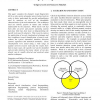Free Online Productivity Tools
i2Speak
i2Symbol
i2OCR
iTex2Img
iWeb2Print
iWeb2Shot
i2Type
iPdf2Split
iPdf2Merge
i2Bopomofo
i2Arabic
i2Style
i2Image
i2PDF
iLatex2Rtf
Sci2ools
123
click to vote
VIZSEC
2004
Springer
2004
Springer
Passive visual fingerprinting of network attack tools
This paper examines the dramatic visual fingerprints left by a wide variety of popular network attack tools in order to better understand the specific methodologies used by attackers as well as the identifiable characteristics of the tools themselves. The techniques used are entirely passive in nature and virtually undetectable by the attackers. While much work has been done on active and passive operating systems detection, little has been done on fingerprinting the specific tools used by attackers. This research explores the application of several visualization techniques and their usefulness toward identification of attack tools, without the typical automated intrusion detection system’s signatures and statistical anomalies. These visualizations were tested using a wide range of popular network security tools and the results show that in many cases, the specific tool can be identified and provides intuition that many classes of zero-day attacks can be rapidly detected and analyze...
Related Content
| Added | 02 Jul 2010 |
| Updated | 02 Jul 2010 |
| Type | Conference |
| Year | 2004 |
| Where | VIZSEC |
| Authors | Gregory J. Conti, Kulsoom Abdullah |
Comments (0)

